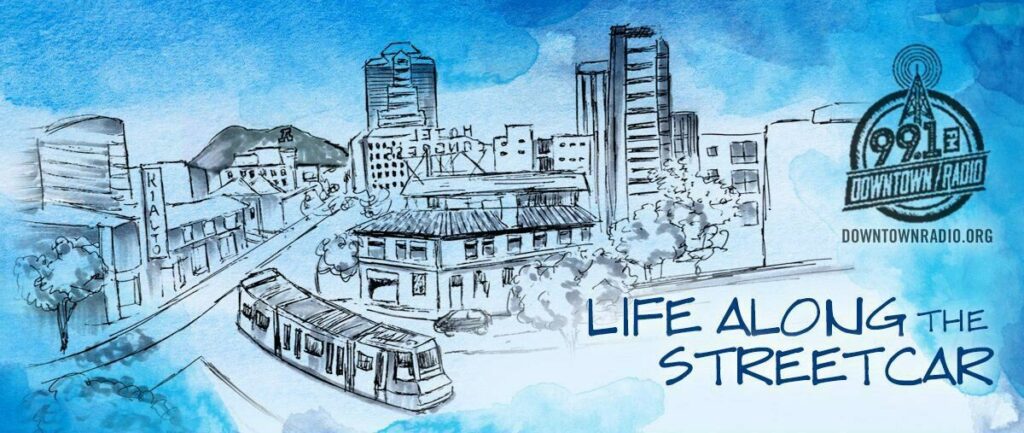Transcript
Tom Heath: Good morning Tucson! It’s a beautiful day in the Old Pueblo. Thank you for spending a part of your brunch our with us on your downtown Tucson Community sponsored rock and roll radio station this week. We’re going to discuss major accomplishments with multiple local chefs.
Tom Heath: Today is February 9th. My name is Tom Heath and you are listening to Life along the streetcar. Each and every Sunday our On social cultural and economic impacts in Tucson’s Urban core and we shed light on hidden gems. We think everyone should know about.
Tom Heath: From A mountain to UArizona and all stops in between, you get the inside track right here on 99.1 FM straining our DowntownRadio.org also available anywhere you go by downloading our very own Downtown Radio Tucson app to your iPhone or Android once it’s in there. You’ve got us. All day all night all week. You can reach us by email on the show right here directly contact it Life along the streetcar dot-org head over to Facebook. If you want to interact with us there. We’re also on Twitter at streetcar life. And if you want to check out our past episodes, we invite you over to our website, which we’re continuing to build out and that is Life along the streetcar dot.org.
Tom Heath: We’re going to start Today’s Show. with some bondage and erotica. February 14th, That’s a date that inspires some it scares others, it’s a day that excites and depresses. But there’s no doubt about it. It’s a celebration of love on Valentine’s Day, February 14th.
Tom Heath: Well this year, on February 13th, the last full day where you can really make something special happen that last minute before the big day this Thursday the 13th. You can head over to Thunder Canyon Brewery and downtown to sample a night of all things erotica.
Tom Heath: As part of the Tucson Erotic Art Show, they do this annually, they’ve put together a an evening with a vendor market and an erotic Extravaganza. So it’s going to be Thursday at Thunder Canyon Brewery. There’s going to be demonstrations a live DJ erotic art that vendors Market, we talked about a sexy raffle, which I don’t know what that is, but that sounds kind of exciting and of course, they’ll be some food and drink specials courtesy of those at Thunder Canyon.
Tom Heath: There’s some demonstrations open from 7 to 11 p.m. Aurora Deshazo is going to be there demonstrating the art of Japanese Rope Bondage and there’s also a sign-up sheet. If you want to get tied up by Aurora in a safe environment/ from eight to ten. Kinetic Art, Tucson’s premier location for pole dance, aerial arts and other disciplines will be showing how to Dazzle on the pure power of the pole. How it’s done with style Grace and a whole lot of strength. I can imagine. It’s a pre Valentine’s Day pop-up market. So if you’re interested, we’ll link to that on our Facebook page after the show and fight you to head over there and check out the details.
Tom Heath: Something else known for on Valentine’s Day is a nice dinner you go out and probably got to make reservations because everybody’s out that night. Well, there’s been a lot of chefs in the news in the last week. So we thought we’d going to catch up on a little bit of that news and tie it back to a story we did on the city of gastronomy and 2019. Most recently. You may have heard that Moma drill. He is the owner of a food truck called geronimo’s Revenge. Truck that has gotten numerous Awards here in Tucson, and it was voted the best food truck in the city might have done that a multiple times, but he was recently on the Food Network’s Grocery Games with Guy Fieri. He was on there and he competed represented Tucson well and won his Grocery Games.
Tom Heath: If you’re not familiar with the show, there is an episode where the chefs there’s usually I think there’s four of them and they are in a grocery store and they have to get certain ingredients or they can’t get certain ingredients to cook a dish and throughout the day Fieri throws obstacles in their way makes them do crazy things and they have to put together some delicious food and its environment under a tight time clock. Well Mo Bodell won his round of Grocery Games. So he walked away as a winner. Just saw that on television last Wednesday. He’s not the only one here in Tucson. We did have Travis Peter’s from the Parish competed a couple of years ago one as well.
Tom Heath: So Tucson is at least two wins on Guy’s Grocery Games, but we we taught we remembered most name because back in 2019. We did a story on the city of gastronomy and we had the executive director Jonathan Avery and the president of the board Janos Wilder and did an interview with them about the importance of this designation. And what would Rose name?
It came up at that point as well because he was selected by the city of gastronomy here in Tucson to go and represent to China in a demonstration of a culinary culinary skills and local Cuisine traveling that around the world and I remember the quote and it was Janos Wilder saying that moment drill and put together a noodle dish to take to China and this is a direct quote from Jana. That’s pretty ballsy to take a noodle dish to China but he did using ingredients here in Tucson and creating something that they had never seen over in China. So when we drill is not new on the food scene, he has got a good reputation a great reputation here in Tucson.
And now it’s starting to spread across the country also in the interview that we did with Jonathan. Mayrand Janos. We talked about kind of where the city of gastronomy was going and one of the things that they announced is that they were going to be starting to certify restaurants that meet within the the standards that it takes to get the the city of astronomy designation and they’re a couple here in the urban core that were just announced. So we just wanted to highlight those and congratulate those individuals.
Tom Heath: We have Maria Maizon, who is at Boca Tacos that used to be down there on the speedway near the campus and she moved over to 4th Avenue few years ago and has been doing pretty well. They’re from what I can tell every time I go by the place seems to be packed. Salsa’s are her her signature. She is a prolific salsa maker, but her food is fantastic as well.
And then we also another Mexican restaurant space which has a place over at the Mercado with the kind of the walk up area there and you you order and sit down but space is done pretty well and the owners of that Erica Jake Munos. Congratulations to you. So we will link to all of the restaurants that are getting this designation here in when T20 without today be a really good day to sort of go back and share that interview that we did with Janos and Jonathan Mabry. So we’re going to play that for you. It’s actually the second part of a two week segment that we did the first the first one which we’re not going to hear today is about how the city of astronomy came to Tucson the efforts and what it took to bring us to that point. Today’s episode is it’s going to be more about the impact of that designation and what the future holds so Listen to our 2019 interview with Janos Wilder and Jonathan Mabry of the Tucson City of Gastronomy.
Jonathan Mabry: I think that one of the things that Tucson chefs excel at, the chefs that we’re sending are using our heritage ingredients in Creative new dishes that they’re inventing? And they’re learning and I’m learning that that’s not the approach of all of the other cities of gastronomy. We’ve learned that most of the other cities of gastronomy. They’re emphasizing their traditional dishes and then in their approaches those dishes are their cultural traditions, and those dishes need to be made the same way with the same ingredients.
Jonathan Mabry: And then we have cities like Tucson and and San Antonio we have a lot of chefs who are we not only know how to make these traditional dishes of our region, but we have so much creativity among our chefs and they’re creating new dishes using our heritage ingredients and they’re doing that in San Antonio to and a few of the other cities with Gastronomy so it gets Two different concepts of authenticity.
Jonathan Mabry: So most of the cities of gastronomy authenticity means making the traditional dishes with the with the traditional ingredients with the traditional preparation techniques and the traditional recipes and in their cities like to sauna San Antonio and most are cylinder, Sweden and others where It’s incredible how creative the chefs are being with with the traditional ingredients. And and and that’s authentic to and UNESCO recognizes that explicitly as often is authenticity because it UNESCO defines.
Jonathan Mabry: Food Heritage is living Heritage and it’s constantly being recreated. It’s not fixed and unchanging and and then I just learned about another concept of authenticity among the cities of gastronomy. That several of the cities of gastronomy in East Asia. Their chefs are open to new ingredients. But them authenticity is using the traditional preparation techniques. So it’s just interesting to see how varied the the concepts of authenticity are.
Janos Wilder: So I think that’s a really interesting conversation to have so in this country and others that that should mention the wrong of the chef is become defined and I’d say the last 35 to 50 years as one it begins to break tradition and changes cuisine to become consistent with modern life. So for instance and in France, you have a Cuisine that’s comes a long history of Cuisine, but most and the most recent and not the most recent but recent Incarnation through crammin escoffier who codified the food and the style of cooking was long meals and lots of preservation techniques.
Janos Wilder: And didn’t have a lot of refrigeration and it was just and it was part of the aristocracy and the aristocracy. The only ones that can afford eat that way modern Cuisine has been democratized. And so everybody is electric can get in this country. We’re a wealthy country and a lot of people are able to eat. Well in the job of the chef is to modify recipes and create recipes that can be great. In everyday basis or on a note the same basis and constantly push the envelope a bit in my mind.
Janos Wilder: One of the things that I went through as a young Chef learning about about business really there were models, but for this learning on my own authenticity was very important to me and learning about the ingredients but not only the ingredients that techniques is well in So I would take and sort of Define what I call the cultural Colony. I culinary icons like a chile. Relleno and determine what is the ideal type of that. What is that in its most basic best form? Which went? How did what kind of chili do you use?
Janos Wilder: How do you prepare the chili so that so that so that they’re prepared properly that there they can maintain their Vitality of their color their thickness their flavor. Lots of technique driven things that was Personal role for me is I wanted to become true to what our heritage was but then expanded and use it as a Point of Departure and by being authentic with with with technique and with ingredients but change it up from there. So not be not having to conform to any preconceived notions.
Tom Heath: So how does how does one get to that that part of a chile Relleno? Is this they are you researching or you are you eating it? Different restaurants, are you how do you figure out what the essence of a chile relleno means?
Janos Wilder: it becomes an intellectual exercise first so intellectually, what is this dish? Is it are you going to define the chile? Relleno by what’s inside of it? Or you’re going to find it. Are you going to Define it by the Chilean the use of the Chilean I make make a different choice. I made the choice. I wanted to find it by the chili and how the chili is handle. That’s the first thing so the techniques to preserve the chili.
Janos Wilder: It was more of a response to the front of 20 acres I had and then okay, so is it battered or is it not if it’s battered? What kind of batteries are you going to use? How do you how do you how do you bat or something like that? If you want to use a batter and not hide the flavor then what are those feelings going to be and me at that point that the whole world is open to you at?
Tom Heath: so this is going to sound like a silly question especially as I’m asking this to the two of you but why is authenticity so important?
Jonathan Mabry: Every place has a different history than a different story to tell and so I believe that authenticity is a way for people to express the continuity of their story in that place.
Janos Wilder: From the chef’s perspective it’s really important to me because it feels right and important powerful to be connected to the entire Continuum of culinary history. Welcomes know our place in that and have respect for what came before while moving forward and that’s happened in almost all areas all areas of life. But that connectivity to the past is what grounds you and adds depth and meaning to your life.
Tom Heath: So even even a restaurant owner in Tucson for 30 plus years. Yeah, and it sounds like every day you’re still learning.
Janos Wilder: Yeah. Oh my goodness.
Tom Heath: So these are these newer chefs that that are coming up that you’re training as ambassadors. You’re probably learning things from them that
Janos Wilder: oh, you better believe it. That’s one of the most thrilling pieces about it here.
Jonathan Mabry: The last the most recent Chef that we sent to represent Tucson. We selected a food truck chef. And of course, this is the food truck that was voted the best food truck in Tucson the last two years in a row geronimo’s Revenge Moma drill and He taught us some new things didn’t he?
Janos Wilder: Yeah, well, he he he was really steep in the in the region. He’s part native American is part of Hispanic. He has a long Heritage and he and the thing was really interesting about him was he was able to really personalize a lot of the culture and traditional stories and mythology as well so you can drive a lot of historical. Into the ingredients the explanation of the ingredients which he was he was using and in some cases myths that I did it. I didn’t know he probably did a maybe didn’t and with those traditional ingredients he invented An entirely new dish. Yes. Yes. He did. Yeah, and when to take the China he did he need a noodle dish and you know kind of ballsy taken a noodle dish to China but it was a kind of noodle that they had never seen before. Yeah based on course.
Tom Heath: We’re in the middle of our interview with Janos Wilder of downtown kitchen cocktails and Jonathan Mabry the executive director of the Tucson city of gastronomy. We back to the second half of that interview about things that are coming. I want to remind you though that you are listening to Life along the streetcar on Downtown Radio, 99.1 FM and streaming on Downtown Radio dot-org. We’re going to hear the second half of our interview today from 2019. We originally our this in 2019 with the honest Wilder and Jonathan Mabry talk about the city of gastronomy.
And in this episode kind of talk about the future of what that designation means and they’re actually going to reference a certification process that they’re undertaking and they have actually launched that here in 2020 and we announced a couple of restaurants Seis Mexican restaurant and Boca Tacos, two of several others in the area that have received that designation and a will head over to Facebook afterwards and Link all of the restaurants so that you can see them all, but back to our second half of the interview.
So here’s a good problem to have but with all this Talent a coming, can Tucson sustain this level. Do we have the population that that can can support this?
Jonathan Mabry: Sustain this creativity? Yeah. Absolutely.
Janos Wilder: Yeah, I would pivot that I would actually pivot there because it’s not just the base population, which is always an increasing but it’s the tourist population mean that that is that’s a big economic boost. So this is Big economic driver and the tourism that that become having this designation brings to us and that in the demands that they have or that spec I would better put as expectations. They bring is going to continue to push this in perpetuated for so the figure is that since we’ve got this designation there has been over 31 million dollars worth of Unpaid advertising is advertising or journalism on the city of astronomy. The research shows that that one of the two of the things that people are looking for when they travel Mount travels different Travelers are different than they were 20 and 30 years ago longer ago than that. It’s the word authenticity comes up again.
Janos Wilder: And there is culinary travel. People are traveling on their stomachs and they want new experience and experience that can only be had where they were where they’re traveling to so that really sort of that creates even more more demand.
Jonathan Mabry: And with all this media attention about our UNESCO Gastronomy designation more and more tourists are coming to Tucson for the food and visit Tucson. Told us recently that since the designation there’s been a 14% increase in the dollars spent by tourists in our restaurants and last year in 2018 visitors spent six hundred and ninety four million dollars in our restaurants.
Tom Heath: That’s a lot of chile rellenos. That’s what
Janos Wilder: We actually have a program that is designed to make it easier. Not only for tourists to find restaurants that are following the precepts. I supposed if you will of city of gastronomy and the foods of the region but both tours and for people who live here and we have just initiated a certification program. So that restaurants can be Five as Tucson City of Gastronomy, sort of certified restaurants and we’re just launching that right now. It’s this is this is is really kind of a big deal. I think locally and will be a big deal nationally and it would be a really big deal with in our Creative Cities Network because this is something that no other city is doing and we’re going to be leading the way and it had a great this is As well as our Ambassador program. Not many doing anything with like we’re doing in our basketball program either.
Tom Heath: It’s fantastic. So what’s next on the horizon? What’s I mean besides the the application process? What’s the big things coming up?
Jonathan Mabry: Well, we are working with the McGuire Center for entrepreneurship at the Eller College of Management at the University on developing a regional food brand for Southern Arizona. So that consumers can Recognize when they go into the stores. What are the what are the truly Local Foods of this region and not not foods that most of the ingredients are being imported and they’re just the products are just being packaged here. But know the ingredients the ingredients are from here and its unique food products that include Regional ingredients so we think that there’s a consumer interest in this and we know that there’s interest by visitors and I mean when you go to a city in another part of the world, aren’t you looking for? What are the food products that I can’t find anywhere else? I want to bring some of those home. That’s what everybody’s looking for. That’s exactly right. Yeah. We’re excited to get going on that project. And we’re still thinking it through we’re still studying these types of hyper local food brands and in other regions to learn from them and we’re going to do it here.
Janos Wilder: That that’s that’s a that’s going to be another sort of Game Changer because your…
Tom Heath: Tucson seems to be changing this game quite a bit.
Janos Wilder: Come back to us next fall. We’ll have a whole new mystery stuff for you. Yep. Well listeners can always keep up with what’s going on and learn more about the designation and about the what the nonprofit is doing by going to the website Tucson.CityOfGastronomy.org
Tom Heath: That was Jonathan Mabry of Tucson city of gastronomy. He was joined by Janos Wilder and again that was recorded back in 2019. So some of the things I’ve talked about are in place and congratulate those restaurants that are receiving that City of Gastronomy designation. You can check them all out on our Facebook page will have a link there for you after the show. My name is Tom Heath. You are listening to Life along the streetcar downtown radio 98.1 FM and available for streaming on Downtown Radio dot-org.
Tom Heath: Well today’s show is complete episode number 122 is in the books head over to Life along the streetcar.org if you want to catch up on any of our past episodes and if you check out on Facebook will have some links for you later today. And then of course the show will be available for podcast later in the week.
Tom Heath: We’re gonna leave you with a little music today from Katie Haverly. She’s here in Tucson. And because we have so much activity happening in our culinary world. This is a what I think of Tucson kitchens right now. There is a fire in the kitchen. Have a fantastic week and please tune in next Sunday for more Life Along the Streetcar.



